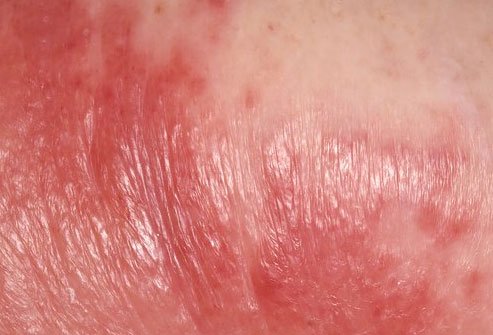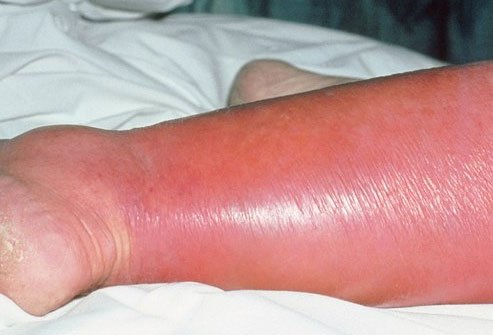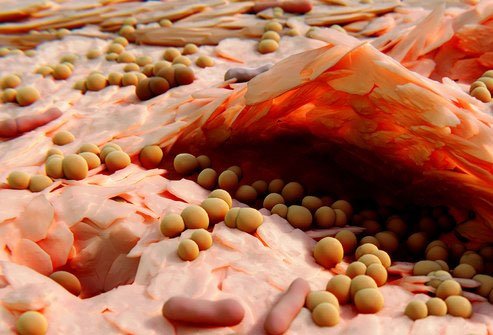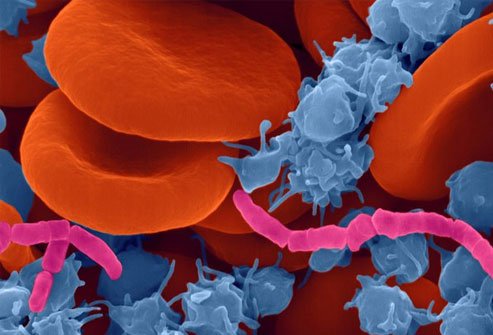Cellulitis: Pictures of Causes, Symptoms, and Treatments
What Is Cellulitis?

Cellulitis is an infection that occurs when bacteria enter the skin and causes a dimpled appearance due to the presence of fatty deposits. You may develop cellulitis when you suffer a cut or break in the skin. Cellulitis may be potentially life-threatening so call your doctor right away if you develop the condition. Skin affected by cellulitis is swollen, red, and tender to the touch.
Cellulitis Symptoms

Cellulitis occurs most often on the lower leg, but other parts of the body may be affected as well. Periorbital cellulitis is cellulitis by the eye. Cellulitis may also occur on the arm, breast, abdomen, and other areas. Cellulitis symptoms may include:
- Red, painful rash with scabs and blisters
- Feeling of warmth on the skin
- Achy dull pain, tenderness
- Chills and fever
- Tender lymph nodes, swollen glands
- Skin swelling
Bacterial Causes

Cellulitis infection is most commonly caused by two types of bacteria, Staphylococcus aureus (staph) and Streptococcus aureus (strep). These bacteria live on the skin and in the nose and mouth and do not normally cause problems. However, all it takes is to get a cut -- even a small one -- that allows the bacteria to enter the skin. Then the bacteria multiply and lead to infection and swelling.
Cellulitis Diagnosis

Most cases of cellulitis are mild and a doctor can easily identify what is causing your skin condition. No tests are needed to diagnose mild cases of cellulitis. Sometimes doctors may order blood culture tests or tissue culture tests to identify the type of bacteria responsible for the infection. These tests may be ordered for those who suffer from severe cases of cellulitis or those who have underlying health problems.
Cellulitis Testing

Lab tests are unnecessary for those who have a mild case of cellulitis. Certain symptoms make it more likely your doctor will order additional testing. These include:
- The presence of an animal bite
- The presence of a serious condition like diabetes or cancer.
- The presence of fever or other potential signs of systemic infection
- The presence of a severe skin infection
- Inadequate response to the first antibiotic prescribed
Is An MRI Necessary?

Sometimes doctors order a magnetic resonance imaging (MRI) test for patients who have cellulitis symptoms. The imaging can help the doctor determine whether symptoms are due to cellulitis or a bone infection called osteomyelitis. A doctor may be more likely to order an MRI if any of the following are present:
- Inadequate circulation in the lower legs
- Immune system dysfunction
- Diabetes
- Lymphedema (swelling)
Misdiagnosis Is Possible

Symptoms of cellulitis mimic those of other skin disease and conditions, so it’s important to get checked out by a doctor who has expertise in dermatology. Conditions that mimic cellulitis include:
- Contact dermatitis: This is a rash that may develop after coming into contact with an irritating substance.
- Stasis dermatitis: This is a type of swelling that occurs due to inadequate circulation, usually in the lower leg
- Panniculitis: This is a type of inflammation that occurs in subcutaneous fat that lies under the skin.
Antibiotic Treatment

Antibiotics are used for cellulitis treatment to eradicate the bacterial infection. Different antibiotics are used depending on the severity of the infection.
Mild cases of cellulitis are treated with oral antibiotics such as dicloxacillin and cephalexin. Severe cases of cellulitis are treated with intravenous antibiotics that are administered directly into the veins.
Take antibiotics exactly as your doctor prescribes and do not skip doses. Finish the whole course of antibiotics to reduce the risk of the infection becoming worse.
Home Care Treatment

Cellulitis is treatment with antibiotics, however there are some things you can do for cellulitis home treatment. If you have cellulitis on your leg or arm, raise the affected limb above your heart propped up on some pillows. Elevating the limb helps decrease swelling and encourages faster healing. Keep the affected area clean and dry. It is okay to bathe, just be very gentle with the skin patting it dry. Do not rub the area. It may irritate the skin. Do not use antibiotic cream or ointment on the affected area.
Recovery

People who have mild cases of cellulitis and receive prompt treatment can begin to recover relatively quickly. Many people will notice fever and chills dissipating 1 to 2 days after starting antibiotics. Warmth and swelling may recede within a few days although do not be surprised if the symptoms last a few weeks. Always let your doctor know if you do not feel better within a few days of starting an antibiotic. It is possible you may need testing and/or to try a different prescribed antibiotic.
Can You Spread Cellulitis?

How do you get cellulitis? It is a bacterial infection that occurs in the deep layers of the skin that results when you get a break in the skin that allows bacteria to enter the body. Person to person spread of cellulitis does not usually occur. It is still a good idea to wash your hands frequently if you have cellulitis or if you are around someone who has it. Use common sense and do not share personal items with someone who has cellulitis. Towels are one example.
What Puts You at Risk?

What is cellulitis caused by? Cellulitis is a bacterial infection deep within the skin. It is more likely in cases where people have:
- Skin conditions like athlete’s foot, shingles, or eczema
- Diabetes or other immune system problems
- Pressure sores, lymphedema, puncture injuries, insect bites, animal bites, or surgical incisions
- Injuries received while being in a body of water like a river, lake, or ocean
- Injectable drug use
Hot tub use is another risk factor associated with cellulitis.
Potential Complications: Cellulitis When to Worry

The sooner cellulitis is diagnosed and treated, the better. Untreated cellulitis can potentially lead to complications. An ongoing infection may lead to bacteria entering the bloodstream, a potentially life-threatening situation. In the case of recurring cellulitis, the condition may cause chronic limb swelling and injure the lymphatic drainage system. Necrotizing fasciitis may result from infection of the fascia tissue and is a medical emergency.
Cellulitis: Pictures of Causes, Symptoms, and Treatments
IMAGES PROVIDED BY:
- Science Source
- Science Source
- Thinkstock Photos
- Thinkstock Photos
- Thinkstock Photos
- Thinkstock
- Science Source
- Thinkstock Photos
- Thinkstock Photos
- Thinkstock Photos
- Thinkstock Photos
- Thinkstock Photos
- Science Source
REFERENCES:
- Mayo Clinic: "Cellulitis," "Cellulitis: How to Prevent Recurrent Episodes," "Cellulite."
- UpToDate: "Skin and soft tissue infection (cellulitis) (Beyond the Basics)," "Cellulitis and skin abscess: Clinical manifestations and diagnosis," "Panniculitis: Recognition and diagnosis," "Cellulitis and Skin Abscess in Adults: Treatment."
- U.S. National Library of Medicine: "Cellulitis."
- Dermatologic Therapy: "Cellulitis: Diagnosis and Management."
- American Academy of Dermatology: "Stasis dermatitis," "Contact dermatitis," "“Contact Dermatitis: Who Gets It and Causes."
- Merck Manual: "Cellulitis."
- Radiographics: “Soft-Tissue Infections and Their Imaging Mimics: From Cellulitis to Necrotizing Fasciitis.”
© 1996-2022 WebMD, LLC. All rights reserved.
Source slideshow on OnHealth


